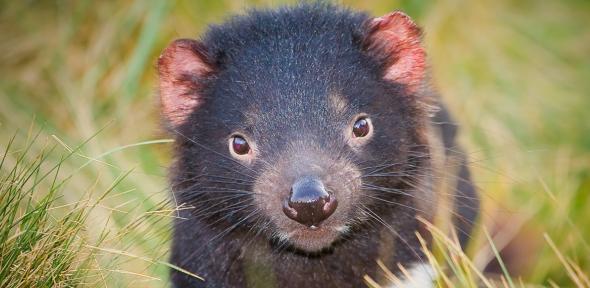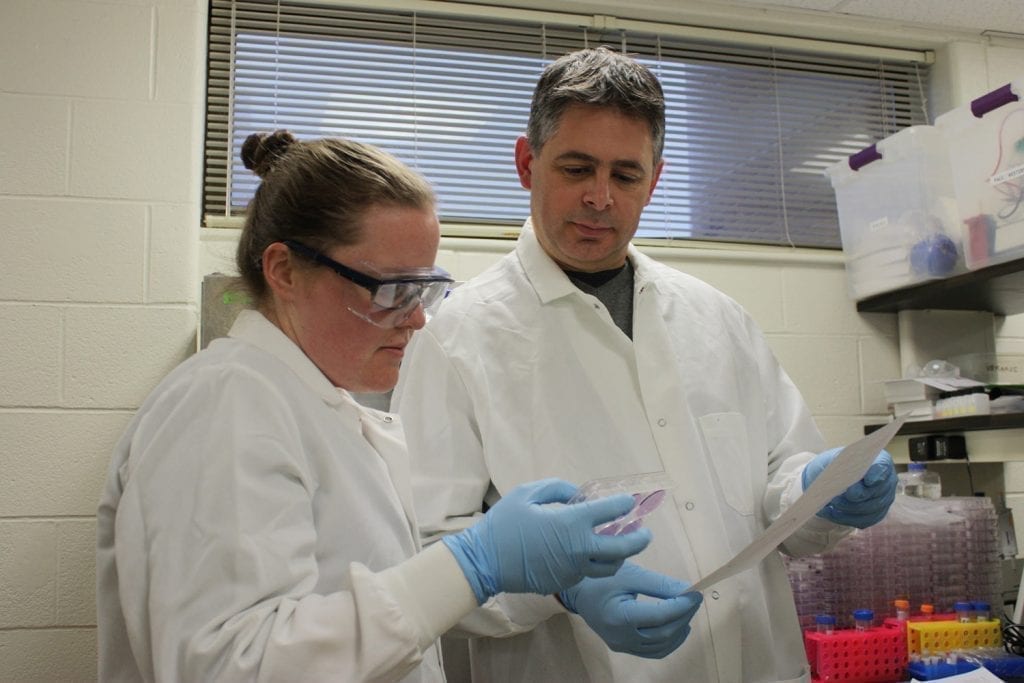
Research paves way for the development of a vaccine for the contagious cancer which is driving Tasmanian devils to the brink of extinction.
New research paves the way for the development of a vaccine for the Tasmanian devil, currently on the brink of extinction because of a contagious cancer.
It has been less than two decades since scientists discovered the contagious cancer devil facial tumour disease (DFTD) which causes 100 per cent mortality in the endangered marsupials. The facial cancer, which spreads when the devils bite each other’s faces during fighting, kills its victims in a matter of months. As it has already wiped out the majority of the population with sightings of devils reduced by 85 per cent, scientists are desperate to find out more about the mysterious cancer which somehow manages to evade the devils’ immune system.
Until now, scientists have believed that the tumours were able to avoid detection by the immune system because the Tasmanian devils have very little genetic diversity (preventing the immune system from recognising the tumour as foreign). However, a University of Cambridge led collaboration with the Universities of Tasmania, Sydney and South Denmark has discovered that the explanation is more complex.
On the surface of nearly every mammalian cell are major histocompatibility complex (MHC) molecules. These molecules enable the immune system to determine if a cell is friend or foe, triggering an immune response if the cell is foreign and a potential threat. The new research, published today, 11 March, in the journal PNAS, reveals that DFTD cancer cells lack these critical molecules, thereby avoiding detection by the devils’ immune system.
Professor Jim Kaufman, from the University of Cambridge’s Department of Pathology, said: “Once it was found that the cancer was escaping from the devils’ immune system, scientists needed to figure out how.”
The researchers found that the DFTD cells have lost the expression of MHC molecules, but that the genes that code for these molecules are still intact. This means that these genes could potentially be turned back on. Indeed, the scientists showed that by introducing signalling molecules such as interferon-gamma, a protein which triggers the immune response, the DFTD cells can be forced to express MHC molecules.
Dr Hannah Siddle, lead author of the paper from the University of Cambridge, said: “Developing a vaccine based on our research could tip the balance in the favour of the devil and give them a fighting chance.”
The Latest Bing News on:
Tasmanian devils
- How soon could we have a vaccine for Tasmanian devil facial tumour disease?on May 7, 2024 at 9:27 am
Researchers will soon be able to trial a vaccine for the deadly Tasmanian devil facial tumour disease, and if all goes to plan, it could be helping the marsupials in as little as four years.
- Tasmanian sign ranks highest in most liked Instagram funny road signs across Australiaon May 4, 2024 at 6:09 am
The unusual site of a Tasmania Devil sign isn’t quite as uncommon in our Apple Island, but one altered sign takes the cake.
- Columbus Zoo announces death of 5-year-old Tasmanian devil named Thymeon May 2, 2024 at 7:52 am
The Columbus Zoo and Aquarium announced the death of the last member of its original family of Tasmanian devils. Thyme came to the Columbus Zoo from Tasmania, an island state located south of ...
- Thyme, Tasmanian devil at the Columbus Zoo, dies at 5 years oldon May 1, 2024 at 12:45 pm
COLUMBUS, Ohio – A Tasmanian devil described as a cherished member of the Columbus Zoo who had an infectious love for life has died.Thyme, a 5-year-old Tasmanian devil, died after facing health ...
- Thyme, Tasmanian devil at the Columbus Zoo, dies at 5 years oldon May 1, 2024 at 12:45 pm
A Tasmanian devil described as a cherished member of the Columbus Zoo who had an infectious love for life has died. Thyme, a 5-year-old Tasmanian devil, died after facing health issues that may have ...
- Tasmanian devils survive facial tumour disease with hope for human cancerson April 26, 2024 at 5:00 pm
Peter Hadfield reports. Elise Ringwaldt: So what I'm doing here is I'm just transferring Jillie, our Tasmanian devil, into the sack. What I'm going to do is I'm going to go 1-2-3-tip, and so we're ...
- I Got a Close Look at Tasmania’s Famous (and Endangered) Wildlife — Here’s How Travelers Can Help Preservation Effortson April 26, 2024 at 5:00 pm
“There’s one!” someone in the group called out. It was a Tasmanian devil, the world’s largest carnivorous marsupial. (The animals are actually quite small, standing about a foot tall and ...
- Talk of the devil! Tasmanian devil finds new home at Australian zoo to join breeding programon April 20, 2024 at 7:22 am
A Tasmanian devil has arrived at his new home at an Australian zoo as part of an effort to support a breeding initiative. Three-year-old Quirrell recently made the journey from Launceston in ...
- Tasmanian devil facial tumour research challenged: disease may not be declining after allon April 17, 2024 at 2:49 pm
Tasmanian devils rapidly evolving to resist contagious cancer, study finds She said it was recommended that scientists sequence DNA at least 30 times when analysing tumours to have confidence that ...
- Reports of Tasmanian tiger sightings come by the thousands as Aussies search for extinct thylacineon April 14, 2024 at 4:32 pm
Jon Wertheim: And you're saying that dunnart—that little field mouse marsupial dunnart—is closer than, say, the Tasmanian devil? Andrew Pask: But that little dunnart is a ferocious carnivore ...
The Latest Google Headlines on:
Tasmanian devils
[google_news title=”” keyword=”Tasmanian devils” num_posts=”10″ blurb_length=”0″ show_thumb=”left”] [/vc_column_text]The Latest Bing News on:
Devil facial tumour disease
- How soon could we have a vaccine for Tasmanian devil facial tumour disease?on May 7, 2024 at 9:27 am
Researchers will soon be able to trial a vaccine for the deadly Tasmanian devil facial tumour disease, and if all goes to plan, it could be helping the marsupials in as little as four years.
- Historic Tasmanian dairy Woolnorth hits market after failing to secure milk contracton April 29, 2024 at 3:47 am
“Van Dairy has some of the last devil facial tumour disease-free populations, and we have always treated this responsibility with the utmost importance,” he said. Dairy cows at Woolnort ...
- Historic Tasmanian dairy Woolnorth hits market after failing to secure milk contracton April 28, 2024 at 7:47 am
The remaining holdings of one of the largest and most historic dairy farms in Australia has been put on the market after failing to renew a long-term milk supply arrangement this year.
- I Got a Close Look at Tasmania’s Famous (and Endangered) Wildlife — Here’s How Travelers Can Help Preservation Effortson April 27, 2024 at 6:00 am
Saffire is one of Australia’s most luxurious nature escapes, with wraparound views of Great Oyster Bay and the Hazards Mountains that you can take in from your private patio or, in some rooms, your ...
- Tasmanian devil facial tumour research challenged: disease may not be declining after allon April 17, 2024 at 2:49 pm
Devil facial tumour disease, a fatal cancer spread through biting and sharing of food, emerged in the 1980s. The spread of DFTD led to the species being listed as endangered by the International ...
- Disease Ecologyon December 11, 2021 at 2:43 am
devil facial tumour disease in Tasmanian devils, and sudden oak death in Californian trees. Theory suggests that density dependent specialist pathogens (i.e., those infecting a single host ...
The Latest Google Headlines on:
Devil facial tumour disease
[google_news title=”” keyword=”devil facial tumour disease” num_posts=”10″ blurb_length=”0″ show_thumb=”left”]









